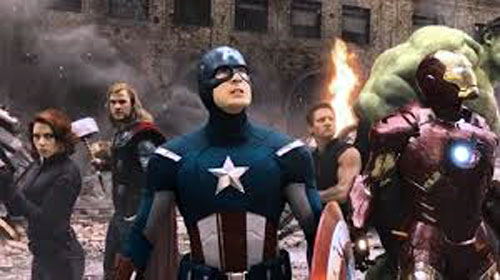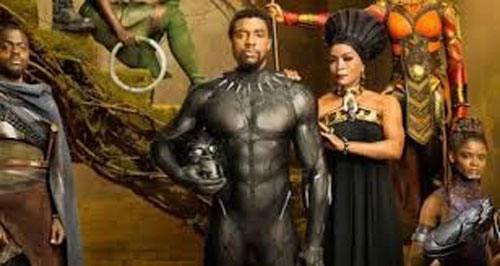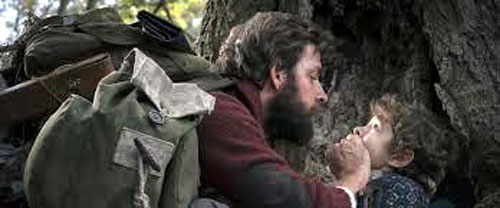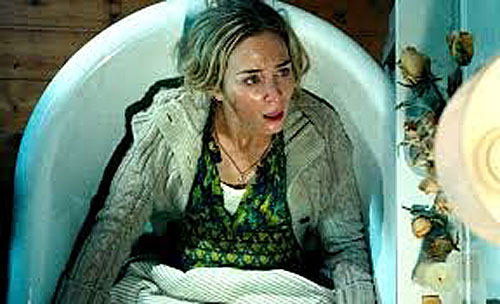|
The Marvel Cinematic Universe is the box-office colossus of our times, and the two Marvel films released early this year--Ryan Coogler’s Black Panther and Anthony and Joe Russo’s Avengers: Infinity War—were the two most wildly anticipated movies in recent memory. I cannot imagine that any fans left either movie feeling dissatisfied, although most of them certainly were in a state of shock after the end of Avengers: Infinity War, which was as close as superhero movies ever come to Elizabethan tragedy.
 |
Avengers: Infinity War brings together most of the Marvel superheroes—Iron Man (Robert Downey Jr.), Thor (Chris Hemsworth), Captain America (Chris Evans), Black Panther (Chadwick Boseman), The Incredible Hulk (Mark Ruffalo), Black Widow (Scarlett Johansson), Spider-Man (Tom Holland), Doctor Strange (Benedict Cumberbatch), etc.—in their fight to keep the evil Thanos (Josh Brolin) from obtaining all six Infinity Stones and gaining control of the Universe. All the beloved, interestingly shaded characters are deployed usefully—none in a mere cameo—in the near-nonstop action, served up with flourishes of awe-inspiring CGI. The supporting cast is also delightful; watch for Peter Dinklage in a particularly witty bit of casting. Adding to the fun is that the Avengers don’t particularly like each other—especially not Iron Man and Captain
America—and that most, if not all, are major smartasses, at least until the aforementioned climactic bloodbath.
I am an ignoramus about the Marvel universe, which is why I found Black Panther the more satisfying of the two movies. I didn’t have to know the whole back story going in (a friend helpfully offered a thumbnail sketch before we saw Avengers: Infinity War together). Instead, Black Panther tells the complete story of one of Marvel’s most fascinating characters. The movie’s special effects are jaw-dropping; its action scenes meet and exceed the hopes of any superhero movie fan; its actors, featuring some of the most illustrious African, African-American and Anglo-African thespians working today, deliver performances far above the usual in movies of this type; and the screenplay by Coogler and Joe Robert Cole is both engrossing and thought-provoking.
Based on the comics by Stan Lee and Jack Kirby, Black Panther tells the story of Wakanda, a Central African nation ruled by King T’Challa (Chadwick Boseman once again), who is also the titular hero. Thousands of years ago, Wakanda was hit by a meteor that contained a metal called vibranium, making it the only place in the world to have it. Vibranium allows Wakanda to be vastly more technologically advanced than any other nation on Earth, while simultaneously using that technology to mask Wakanda’s wealth from envious would-be invaders. A suit of vibranium, as well as a heart-shaped herb infused with the metal, give T’Challa his amazing powers.
Though Wakanda is incredibly advanced, it is also—like other mythical comic-book kingdoms—ruled by tradition and ritual. T’Challa must face challengers to the throne in combat at the edge of a sacred waterfall, without benefit of the suit or the herb. Early on, he bests M’Baku (Winston Duke), leader of the only Wakandan tribe that does not accept the rule of T’Challa and his line. But later T’Challa faces a much deadlier challenge from Erik “Killmonger” Stevens (Michael B. Jordan), a CIA black-ops agent with an unexpected connection to T’Challa.
The action in Black Panther—which among other things takes T’Challa and his crew to Busan, South Korea, for a caper and car chase that puts James Bond to shame—is more than enough to thrill the most jaded fan. But it is the characters of Black Panther, and the moral questions they face, that place the film well above the average. It has become apparent that Wakanda’s continued isolation is untenable, and that it must take its place among nations. But should it use its mighty powers to seek vengeance against the racist world that forced it to secrecy, as Killmonger demands? Or should it offer its aid to the world in the name of peace and harmony, as T’Challa seeks?
Coogler presents this dilemma with urgency and even profundity. (It is not for nothing that Coogler begins and ends the film in Oakland, Calif., his home town and the setting of his first film, Fruitvale Station.) Of course he has a wonderful cast to help him present it. Chadwick Boseman has spent the last several years playing some of the greatest and most varied heroes in African-American history—Jackie Robinson, James Brown, Thurgood Marshall. His talent and charisma enhanced by an awesomely pumped-up body, Boseman is more than ready to take his place among the screen’s superheroes. Jordan is equally impressive, making Killmonger a superbly compelling villain. He announced himself as a star in Fruitvale Station, and in Black Panther it is obvious he’s here to stay.

The excellence of the acting goes straight down the line, including Lupita Nyong’o as Nakia, a Wakandan agent and T’Challa’s former lover; Danai Gurira as Okoye, head of the all-female Dora Milaje special forces; Andy Serkis, CGI-less for once as the despicable black marketeer Ulysses Klaue; Martin Freeman as Everett K. Ross, a CIA agent who is much more likable than movie CIA agents tend to be these days; Letitia Wright as Shuri, T’Challa’s science-genius kid sister, who is smarter than all the other characters put together; and Sterling K. Brown, Forest Whitaker, Angela Bassett and Daniel Kaluuya in smaller roles.
Celebrities including Octavia Spencer, Kendrick Lamar, Snoop Dogg and Ellen De Generes reached deep into their pockets to buy Black Panther tickets for black children. It is easy to understand why, and to applaud them for doing it. I remember James Baldwin’s line, as quoted in Raoul Peck’s I Am Not Your Negro: “It comes as a great shock around the age of 5 or 6 or 7 to discover that Gary Cooper killing off the Indians—when you were rooting for Gary Cooper—that the Indians were you!” I think Baldwin would have bought the children some tickets himself.
Whereas the denizens of the Marvel Universe perform amazing feats of courage, strength and agility, there have been times in history when simply staying alive was a miraculous feat. This is the simple, terrifying thesis of John Krasinski’s A Quiet Place, which is by far the best film Michael Bay (one of the movie’s producers) has ever put his name on.
A Quiet Place begins with a family of five on a shopping trip in their small home town. Only in the closing credits do we learn their names: Lee Abbott (Krasinski), his wife Evelyn (Emily Blunt, Krasinski’s wife), daughter Regan (Millicent Simmonds), and sons Marcus (Noah Jupe) and Beau (Cade Woodward).
Immediately we see that something is terribly wrong. The town is deserted, and Lee and Evelyn must scour the scantily shocked shelves in the general store to find the food and medications they need. They and the children converse only in sign language. The headlines on a stack of unread newspapers tell a horrific story of an invasion of cannibalistic aliens, with the information that they stalk their prey by sound.

Although they live a couple of miles out of town, the family does not have a car, but walks back home. They are all barefoot, walking only on a path of sand that Lee and Evelyn have strewn beforehand.
Before they reach home, the family of five has become a family of four.
This is the first act of A Quiet Place, a horror story of uncommon skill as written by Krasinski, Bryan Woods and Scott Beck. It serves the dual purpose of showing us exactly the dangers the Abbotts face, and of making us hate the aliens.
The film resumes about a year later, and we see the farmhouse-fortress the Abbotts have set up. The family has advantages that aid its survival. Lee is an engineer, so he has set up an extensive warning system that includes a large set of closed cameras. All the family members were fluent in sign language long before the invasion, because Regan is deaf. They also have access to a rushing river and waterfall near their house, which cover the sound of their voices when they need to communicate verbally.
However, the aliens are relentless, and a new development in the Abbotts’ lives (which I will not reveal here) increases exponentially the dangers they face.
A Quiet Place reminds me a great deal of two recent films, Robert Egger’s The Witch and Trey Edward Shults’ It Comes at Night. All three films capture brilliantly the terror of an isolated family facing an unspeakable, unstoppable menace. But A Quiet Place includes something the other two films do not: hope. Unlike the families in The Witch and It Comes at Night, the Abbotts can actually take action to fight the menace. Their tragedies are many, but their fighting spirit never wavers.
John Krasinski has long been a welcome presence in movies and TV, a likable actor with superb comedy timing. With A Quiet Place, however, he leaps to the forefront of Hollywood’s triple-threat actor/writer/directors, and deservedly so. Krasinski understands how to pace a horror film, leaving long spaces between attacks to keep the audience off its guard, and he understands that what the audience doesn’t see is scarier than what it does. But even more, he knows how to save the best for last, so that when we finally do see the monsters close-up in the last half-hour, they are even more horrible than we imagined. Even Ripley from Aliens might have quailed at the sight of these homunculi.

Krasinski’s performance is excellent, and so is that of Blunt. Like her husband, Blunt is a naturally sympathetic performer, and viewers feel protective toward her, a definite plus in a film like A Quiet Place. The dangers she faces toward the end of the film will have your heart pounding, but you will also be gratified by the courage and grit her character reveals.
Among the child actors, the standout is Simmonds. Deaf in real life, Simmonds is brilliant at playing Regan’s adolescent uncertainties, compounded by lingering feelings of anger and guilt.
Avengers: Infinity Wars and Black Panther are top-of-the-line superhero movies, but A Quiet Place is my favorite of the films reviewed here. Alfred Hitchcock was the all-time master at presenting horror and suspense in what should have been safe places, but John Krasinski has learned well from the master. A sequel to A Quiet Place is planned, and I look forward to what Krasinski provides us then, and in the future.
|